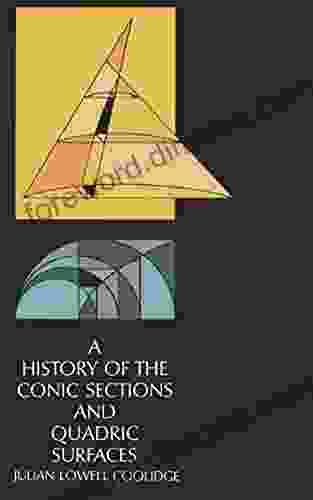Unearthing the Enigmatic History of Conic Sections and Quadric Surfaces

5 out of 5
| Language | : | English |
| File size | : | 17317 KB |
| Print length | : | 3 pages |
| Lending | : | Enabled |
| Screen Reader | : | Supported |
The world of mathematics is replete with fascinating concepts that have shaped our understanding of the universe. Among these, conic sections and quadric surfaces stand out as cornerstones of geometry, with a rich history that spans millennia.
In this article, we embark on a captivating journey to explore the origins, evolution, and significance of these enigmatic mathematical objects. From their humble beginnings in ancient Greece to their profound impact on modern science and technology, we will uncover the stories behind the minds that shaped these concepts and the lasting legacy they have left on our world.
The Dawn of Conic Sections
The earliest known studies of conic sections can be traced back to the ancient Greek mathematician Menaechmus in the 4th century BC. Menaechmus is credited with discovering that conic sections can be generated by intersecting a cone with a plane at different angles. This breakthrough laid the foundation for the systematic study of these curves.
Euclid, the towering figure of Greek mathematics, further developed the theory of conic sections in his seminal work, "Elements." Euclid classified conic sections into three types: circles, ellipses, and hyperbolas, and established their fundamental properties. His work provided a rigorous framework for studying conic sections that would influence mathematicians for centuries to come.
The Contributions of Apollonius
The most comprehensive treatise on conic sections was written by the Greek mathematician Apollonius of Perga in the 3rd century BC. Apollonius expanded on Euclid's work and introduced the concept of the conjugate axis, which led to a deeper understanding of the relationship between different types of conic sections.
Apollonius's work, known as "Conics," is considered one of the greatest mathematical treatises of antiquity. It not only advanced the study of conic sections but also paved the way for the development of projective geometry and other branches of mathematics.
Quadric Surfaces: A Higher Dimension
While conic sections are two-dimensional curves, quadric surfaces are their three-dimensional counterparts. Quadric surfaces are generated by intersecting a cone with a plane at different angles, resulting in a variety of shapes, including spheres, ellipsoids, and hyperboloids.
The study of quadric surfaces began in earnest during the Renaissance period. Mathematicians such as Leonardo da Vinci and Johannes Kepler investigated the properties of quadric surfaces and their applications in art and architecture. However, it was not until the 17th century that a systematic understanding of quadric surfaces emerged.
Descartes and Analytic Geometry
The French mathematician René Descartes revolutionized the study of geometry in the 17th century with the of analytic geometry. Descartes's method allowed geometric objects to be represented by algebraic equations, which greatly facilitated their analysis and manipulation.
Analytic geometry had a profound impact on the study of conic sections and quadric surfaces. It enabled mathematicians to derive their equations and study their properties algebraically, leading to a deeper understanding of their relationships and behavior.
The Impact of Conic Sections and Quadric Surfaces
Conic sections and quadric surfaces have had an immeasurable impact on various fields of science and technology. They are used in:
- Astronomy: Calculating the orbits of celestial bodies
- Engineering: Designing bridges, tunnels, and other structures
- Architecture: Creating aesthetically pleasing and functional buildings
- Physics: Describing the trajectories of projectiles and the behavior of light
- Computer graphics: Generating realistic 3D models
These are just a few examples of the wide-ranging applications of conic sections and quadric surfaces. Their versatility and power make them indispensable tools for understanding and shaping our world.
The history of conic sections and quadric surfaces is a testament to the enduring power of human curiosity and ingenuity. From their humble beginnings in ancient Greece to their profound impact on modern science and technology, these mathematical objects have shaped our understanding of the world around us.
As we continue to explore the depths of mathematics, we can expect conic sections and quadric surfaces to continue to play a vital role in advancing our knowledge and unlocking the secrets of the universe.
5 out of 5
| Language | : | English |
| File size | : | 17317 KB |
| Print length | : | 3 pages |
| Lending | : | Enabled |
| Screen Reader | : | Supported |
Do you want to contribute by writing guest posts on this blog?
Please contact us and send us a resume of previous articles that you have written.
 Book
Book Novel
Novel Page
Page Chapter
Chapter Text
Text Story
Story Genre
Genre Reader
Reader Library
Library Paperback
Paperback E-book
E-book Magazine
Magazine Newspaper
Newspaper Paragraph
Paragraph Sentence
Sentence Bookmark
Bookmark Shelf
Shelf Glossary
Glossary Bibliography
Bibliography Foreword
Foreword Preface
Preface Synopsis
Synopsis Annotation
Annotation Footnote
Footnote Manuscript
Manuscript Scroll
Scroll Codex
Codex Tome
Tome Bestseller
Bestseller Classics
Classics Library card
Library card Narrative
Narrative Biography
Biography Autobiography
Autobiography Memoir
Memoir Reference
Reference Encyclopedia
Encyclopedia Soumya Sundar Mukherjee
Soumya Sundar Mukherjee Dr Brian Metters
Dr Brian Metters E D Burton
E D Burton William James
William James Dr Joyce Starr
Dr Joyce Starr E R Tracy
E R Tracy Jack J Phillips
Jack J Phillips Stephen Brady
Stephen Brady Edwidge Danticat
Edwidge Danticat Dorothy Canfield Fisher
Dorothy Canfield Fisher Donna Snyder Smith
Donna Snyder Smith Ez Academics Publishing
Ez Academics Publishing Edwina Raffa
Edwina Raffa Ebubechukwu O Ilo Okeke
Ebubechukwu O Ilo Okeke John Bellairs
John Bellairs Dot Edu
Dot Edu Edie Jarolim
Edie Jarolim M Eric Ritter
M Eric Ritter Kimberly Kayler
Kimberly Kayler Peter Finn
Peter Finn
Light bulbAdvertise smarter! Our strategic ad space ensures maximum exposure. Reserve your spot today!
 Henry Wadsworth LongfellowFollow ·13.5k
Henry Wadsworth LongfellowFollow ·13.5k Cody RussellFollow ·13.6k
Cody RussellFollow ·13.6k Albert CamusFollow ·5.1k
Albert CamusFollow ·5.1k Jon ReedFollow ·12.8k
Jon ReedFollow ·12.8k Caleb LongFollow ·14.3k
Caleb LongFollow ·14.3k Jesse BellFollow ·19.2k
Jesse BellFollow ·19.2k Terry BellFollow ·5.3k
Terry BellFollow ·5.3k Bobby HowardFollow ·19.5k
Bobby HowardFollow ·19.5k

 Jacob Hayes
Jacob HayesBrave Son Elaine Wick: An Inspiring Tale of Triumph and...
Prepare to be captivated by...

 Dwight Bell
Dwight BellUnleash the Enchanted Journey: Discover "The Pride of the...
Embark on an Extraordinary...

 Winston Hayes
Winston HayesChess for Children: A Journey into the World of...
Unlock the Potential...

 Isaiah Price
Isaiah PriceDiscover the Enchanting West Coast with the West Coast...
Prepare to be captivated by...

 Shannon Simmons
Shannon SimmonsUnveiling the Enchanting Bond: Animals and the Human...
The Profound Connection: A Literary...
5 out of 5
| Language | : | English |
| File size | : | 17317 KB |
| Print length | : | 3 pages |
| Lending | : | Enabled |
| Screen Reader | : | Supported |














